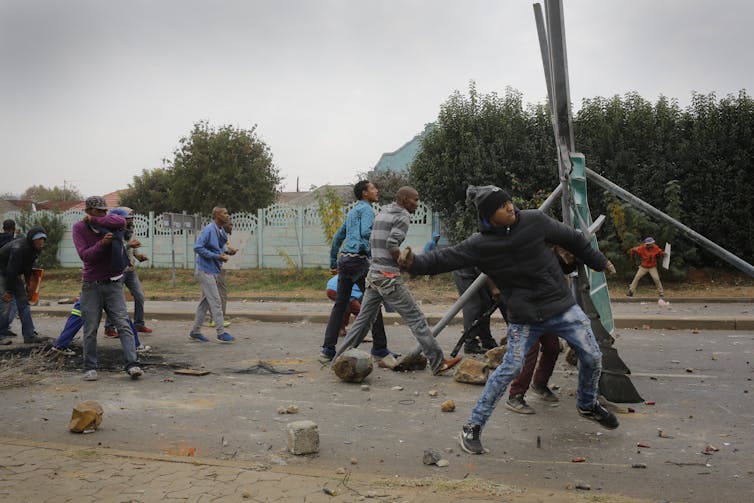
EPA-EFE/Nic Bothma
For the past two years political party coalitions have become the “new normal” in South African politics. They became a key feature in 2016 after the main opposition party, the Democratic Alliance (DA), wrested power from the governing African National Congress (ANC) by forming coalitions in three key metropolitan – Nelson Mandela Bay, Tshwane and Johannesburg.
But the coalitions have proven to be volatile and unstable, most notably in Nelson Mandela Bay. The metropolitan municipality council has found it difficult to pass budgets, approve and agree on a long-term strategic development plan for the city.
After a series of crises, the coalition which had been cobbled together between the DA and three smaller parties finally collapsed in August. Another motion of no confidence – the fifth in two years – was tabled against the DA’s executive mayor Athol Trollip. A slim majority of councillors voted in favour and he was ousted. Trollip has challenged the decision in court. For now the city has a mayor from the United Democratic Movement which has 2% of the vote in the council.
The coalition in South Africa’s second largest city Tshwane is also on shaky ground. The executive mayor Solly Msimanga, also from the DA, faced a motion of no confidence a mere three days after Trollip was ousted. But Msimanga survived to fight another day due to a technical glitch in the voting procedures.
The coalition in Johannesburg seems to be holding – for now.
But the troubles in Nelson Mandela Bay and Tshwane are raising real concerns that the political chess games are affecting accountability, governance stability and service delivery in the cities.
This is a serious state of affairs. If political parties can’t work together, passing resolutions and agreeing on developmental priorities becomes difficult. Once governance stagnates, a municipality cannot function effectively. This in turn affects its ability to provide services. When councils become political theatres, ordinary citizens suffer. This much has been evident in Nelson Mandela Bay.
Political expediency
Coalitions are usually formed on the basis of political expediency. The political marriages of convenience come about when political parties can’t get an outright majority. To secure power, parties scramble to find partners, at times without considering ideological, policy, or historical differences. As African political and governance scholar W. O. Oyugi cited by African human rights expert Dr Japheth Biegnon has noted:
coalitions are a necessary evil – an evil in the sense that normally no party ever coalesces except in circumstances in which not to do so would deprive it of a chance to exercise power
This certainly holds true for the coalitions formed in South Africa since 2016. The cooperation forged among opposition parties was designed solely to get the ANC out of power.
What emerged were uncomfortable coalition governments led by the DA. It promised to root out corruption and improve the delivery of basic services, such as water and electricity, to communities. But it lacked the required majority to govern on its own so turned to building coalitions.
It partnered with a number of smaller parties. One of them, the Economic Freedom Fighters (EFF), helped the DA take over governments in Nelson Mandela Bay, Tshwane and Johannesburg.
The EFF, acutely aware of the power it wields in all these arrangements, has used the fragile political situation at local government level for its own political agenda. This has included promoting its radical stance on land expropriation and nationalisation with an eye on improving its performance in next year’s elections.
The EFF declined to formally join any coalition government, but effectively holds the position of political kingmaker, especially in hung councils.
Both the DA and the ANC realise that, potentially, they might need to work with the EFF in future. It is therefore not surprising that following the Tshwane motion of no confidence, Msimanga announced he would “reach out” to the EFF.
Lessons for the future
There are two key lessons that political parties should take away from the current political turmoil if they want to bring about a semblance of bureaucratic stability.
Firstly, using local coalition politics to advance political agendas can severely hamper service delivery. Secondly, this undermines public trust in local government, creating fertile ground for political unrest.
Political parties will need to heed these lessons to ensure effective governance and political stability in the country. This is particularly important in view of the 2019 national and provincial elections, which are expected to result in even more coalition governments.
If they don’t, ordinary citizens will suffer while politicians engage in a game of chess to secure power. As it is,
South Africans are increasingly dissatisfied with democracy. This is due to a number of factors, including poor service delivery and a lack of societal trust in government.
Ultimately, coalitions need to work for the citizenry, and not politicians.
The author’s has just published a new book, Delivering an Elusive Dream of Democracy: Lessons from Nelson Mandela Bay.
Joleen Steyn Kotze, Senior Research Specialist in Democracy, Governance and Service Delivery at the Human Science Research Council and a Research Fellow Centre for African Studies, University of the Free State
This article is republished from The Conversation under a Creative Commons license.



